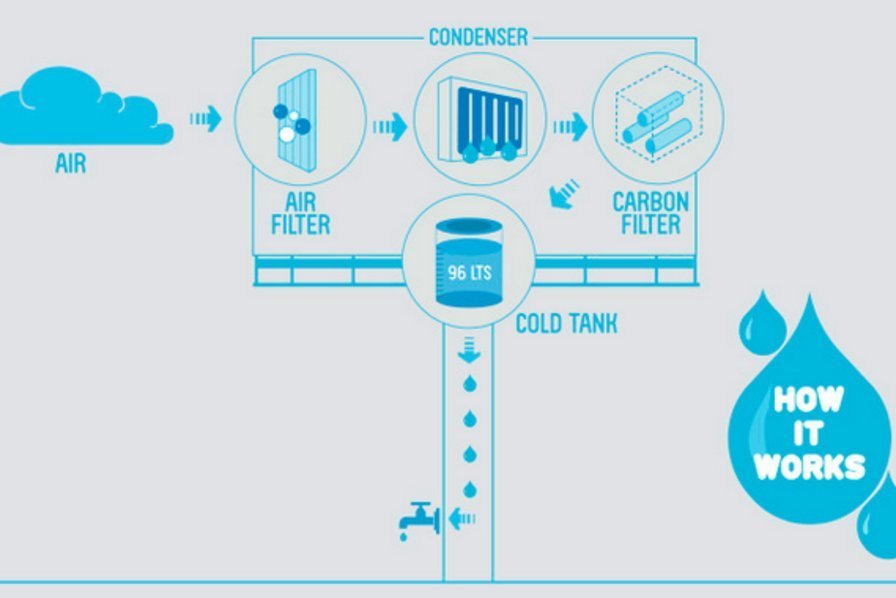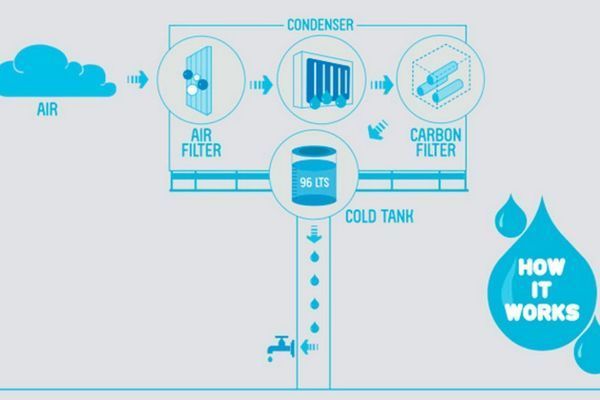Drinking water out of a billboard
Contents
Solution for a problem
Most of the people living in Bujama, Peru take water from the well. This water is contaminated, dirty and not good. That’s their only option due to the extremely dry climate with annual precipitation of less than 1 inch. What they also found out was that the humidity in the air was 98%. A team of UTEC and an agency investigated the matter and worked on a solution. The result is a billboard that generates water from the air. The billboard works through a reverse osmosis system. The billboard only costs $1,200 to develop and was equipped with a pipe and faucet to facilitate easy distribution of fresh water to city residents at the base of the structure.
How does Reverse Osmosis works?
Reverse Osmosis is a process in which dissolved inorganic solids (such as salts) are removed from a solution (such as water). How this team made it work, you can see on the picture above: The air goes through the air filter, capturing the air humidity, then the condensing and purifying the water by carbon filter and filling up the tank. Using the reverse osmosis creates great benefits such as it improves the taste, odor and the appearance of the water. It’s simple to maintain and to clean and saves money this way. It also removes impurities and pollutants from the water because of the carbon filter.
Results and transformative impact
In 3 months the billboard has produced 9450 Lt of fresh and clean water for the people living there. This is a good solution for a major problem that we have on different places in this world. However this idea cannot be used in all places. The minimum humidity that the place must have for the generator to work is 90 %. But I believe that with the right changes and studying this technology (the way it works) that we may be able to make something suitable for other environments. While doing that this billboard concept can be put in other places with the same amount of humidity, and help people and families.
This billboard does not fall under the category of art and social art, but it does under social design project. It’s a great project and concept to transform the world. Looking for new innovative ideas and ways to help this world.
Participatory
As I said before this project was for the people living in Bujama, Peru who had only dirty and contaminated water to drink. So this people did not help make the billboard and cannot change the project, but were the one using it. Meaning it was made for the community and only to the benefit the people and not for themselves (get money). The team that made the billboard was a group of UTEC (engineers) and an agency called Mayo Draft FCB.
Future
Two years later UTEC builds a similar billboard but that purifies the air. The billboard has been built on a UTEC campus construction site in Lima and is capable of purifying 3.5 million cubic feet of urban air daily. This is equivalent to 1,200 trees. The billboard absorbs pollutants, filters them out using basic thermodynamic principles and yields fresh oxygen that extends up to five city blocks. The billboard is also energy efficient, running on recycled water and 2,500 watts per hour. It is also specifically designed to soak up construction materials, including dust and metal particles, to improve air quality for site workers and neighbourhood residents.
UTEC started this project because a recent report suggested that 90 percent of the world's urban population is breathing air that fails to meet WHO (World Health Organization) safety guidelines. Lima, Peru's capital city is among the world's worst air pollution offenders. While air pollution has declined over the last decade, Lima residents remain concerned with the health and environmental risks posed by the quality of their city’s air. This shows that UTEC is literally changing Peru's environmental landscape by not only the billboard that purifies water from the air and creating clean drinking water, but also making billboard that purifies the air.
This is a great innovation, concept and social design that UTEC is doing for their land, and for their people's health. Who knows what else we can do with billboards in the air. Or simply by caring about our world and the people living here. Who knows what the future of the University of Engineering and Technology of Peru has for us.Links
CONTRIBUTE
Feel free to contribute to Beyond Social.
Source: https://www.youtube.com/watch?v=35yeVwigQcc
Reason of the project
In 2012 the university of Engineering and Technology of Peru has made the first billboard that makes drinking water out of air. The reason for this was first of all to inspire young people to study engineering at UTEC. By solving a problem using technology was the best way to do this. Why not have a job where you can help the world and your family?
Solution for a problem
Most of the people living in Bujama, Peru takes water from the well. This water is contaminated, dirty and not good. That’s their only option due to the extremely dry climate with annual precipitation of less than 1 inch. What they also found out was that the humidity in the air was 98%. A team of UTEC and an agency investigated the matter and worked on a solution. The result is a billboard that generates water from the air. The billboard works through a reverse osmosis system. The billboard only costs $1,200 to develop and was equipped with a pipe and faucet to facilitate easy distribution of fresh water to city residents at the base of the structure.
How does Reverse Osmosis works?
Reverse Osmosis is a process in which dissolved inorganic solids (such as salts) are removed from a solution (such as water). How this team made it work, you can see on the picture above: The air goes through the air filter, capturing the air humidity, then the condensing and purifying the water by carbon filter and filling up the tank. Using the reverse osmosis creates great benefits such as it improves the taste, odor and the appearance of the water. It’s simple to maintain and to clean and saves money this way. It also removes impurities and pollutants from the water because of the carbon filter.
Results and transformative impact
In 3 months the billboard has produced 9450 Lt of fresh and clean water for the people living there. This is a good solution for a major problem that we have on different places in this world. However this idea cannot be used in all places. The minimum humidity that the place must have for the generator to work is 90 %. But I believe that with the right changes and studying this technology (the way it works) that we may be able to make something suitable for other environments. While doing that this billboard concept can be put in other places with the same amount of humidity, and help people and families.
This billboard does not fall under the category of art and social art, but it does under social design project. It’s a great project and concept to transform the world. Looking for new innovative ideas and ways to help this world.
Participatory
As I said before this project was for the people living in Bujama, Peru who had only dirty and contaminated water to drink. So this people did not help make the billboard and cannot change the project, but were the one using it. Meaning it was made for the community and only to the benefit the people and not for themselves (get money). The team that made the billboard was a group of UTEC (engineers) and an agency called Mayo Draft FCB
Future
Two years later UTEC builds a similar billboard but that purifies the air. The billboard has been built on a UTEC campus construction site in Lima and is capable of purifying 3.5 million cubic feet of urban air daily. This is equivalent to 1,200 trees. The billboard absorbs pollutants, filters them out using basic thermodynamic principles and yields fresh oxygen that extends up to five city blocks. The billboard is also energy efficient, running on recycled water and 2,500 watts per hour. It is also specifically designed to soak up construction materials, including dust and metal particles, to improve air quality for site workers and neighbourhood residents.
UTEC started this project because a recent report suggested that 90 percent of the world's urban population is breathing air that fails to meet WHO (World Health Organization) safety guidelines. Lima, Peru's capital city is among the world's worst air pollution offenders. While air pollution has declined over the last decade, Lima residents remain concerned with the health and environmental risks posed by the quality of their city’s air. This shows that UTEC is literally changing Peru's environmental landscape by not only the billboard that purifies water from the air and creating clean drinking water, but also making billboard that purifies the air.
This is a great innovation, concept and social design that UTEC is doing for their land, and for their people's health. Who knows what else we can do with billboards in the air. Or simply by caring about our world and the people living here. Who knows what the future of the University of Engineering and Technology of Peru has for us.
Source 2: https://www.youtube.com/watch?v=-HaC5PQXrho
WHO guidelines: http://www.who.int/phe/health_topics/outdoorair/databases/cities/en/










